Tar Spot
February 23, 2022
Background Info
- First identified in 1904 in Mexico.
- Commonly occurred in the Caribbean, Mexico, Central, and South America.
- Plant host of tar spot is believed to be limited to corn.
- 2015 = First detected in the US (Northwest Indiana).
- 2018 = First year tar spot caused “epidemic” like issues in Northern Illinois and Indiana.
- 2021 = Expanded south and west.
- Likely introduced through infected foreign material and has spread over time. Ascospores can travel great distances in wind and water.
Conditions Favoring Disease Development
- Leaf wetness: 7 hours of continuous moisture on leaves. This is a major driver of tar spot development.
- Temperature: 61-70° F
- Relative Humidity: > 75%
- Other contributing factors: low light intensity, continuous corn, standing water in fields/poor drainage, no-till, and high N fertilization.
- Local temps, relative humidity, and annual rainfall make a perfect environment for the biology of this pathogen.

Symptoms
- Tar spot has a 14-21 day latent period, meaning that the pathogen will not show black specks of tar spot until 2-3 weeks after infection.
- Small, slightly raised black specks, (stromata). Circular or elongated.
- Tar spot can develop a necrotic border around the stromata known as a “fisheye lesion.”
- Tar spots can reduce water and nutrient movement, which can result in reduced photosynthesis, yield, and grain quality.
- Estimating the area on corn leaves infected with tar spot can be an indicator for how much yield loss to expect.
- Illinois researchers found that for every 1% increase in tar spot severity on the ear leaf, yield loss increased 0.5-1.0 bu/ac.


Management Tactics
The following is a list of primary and secondary tactics that should be used as part of an integrated pest management (IPM) strategy to help reduce the severity of tar spot.
Primary Management Practices:
- Plant high yielding corn hybrids that have a high tolerance to the disease.
- The list on the next page are tar spot ratings collected from 2021 BRANDT Community Trials. Please keep in mind that these tolerance ratings are only based on 1 year.
- DKC 63-57 and B 14J04 had the greatest tolerance of the hybrids tested in 2021.
- Tolerant hybrids had 15% leaf coverage. Susceptible hybrids had 40% coverage, as reported by the Crop Protection Network (CPN).
- Longer season hybrids may be more susceptible to yield loss from tar spot, according to the CPN.
- The list on the next page are tar spot ratings collected from 2021 BRANDT Community Trials. Please keep in mind that these tolerance ratings are only based on 1 year.
- Avoid high densities and/or narrow rows.
- Especially in fields with a history of tar spot and with susceptible hybrids.
- High plant density/narrow rows increase leaf surface wetness for longer periods of time.
- Manage standing water/excessive irrigation.
- Water/leaf wetness drives tar spot development.
- Aggressive scouting.
- Scout fields regularly once corn has closed canopy.
- Look for other corn diseases and monitor weather forecast.
- Use the “Tarspotter” app (Univ. of Wisconsin) to help predict disease development. The interactive tar spot map should also be monitored.
- Scout fields regularly once corn has closed canopy.
- Fungicides
- Fungicides work best to prevent a disease. Application timing is critical for success.
- By the time you see signs of the tar spot, it will be too late to “erase it.”
- VT/R1-R2 are optimal in a 1-pass system. But in some years/environments earlier or later applications are more profitable.
- Fungicides work best to prevent a disease. Application timing is critical for success.
- Group 7 (SDHI), and Group 11 (QoI, strobi’s) are great options to help PREVENT disease development.
- Use of fungicides with only one of these modes of action could speed up development of fungicide resistance.
- According to Purdue: Revytek, Veltyma, Miravis Neo, and Delaro Complete are consistently top preforming products on tar spot.
- Susceptible hybrids had significant yield increases (20 bu/ac) when a fungicide was applied.
- Fungicide impact on yield will vary by year, hybrid, and product used.
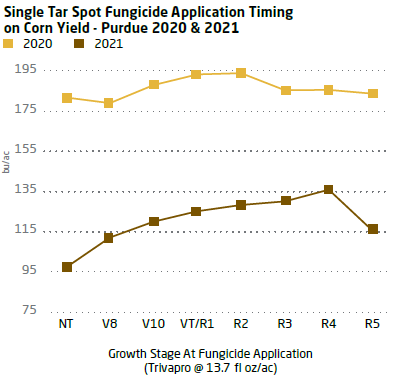
| Tar Spot Ratings - No Fungicide (n = 2) | ||
| Hybrid | Tar Spot Rating (1-10) | Corn Yield (bu/ac) |
| B 09Z08 | 3 | 216.9 |
| DKC 61-41 | 7 | 218.5 |
| DKC 62-89 | 7 | 217.7 |
| B 11Y01 | 3 | 221.1 |
| CP 5244 | 4 | 228.8 |
| DKC 63-57 | 3 | 231.6 |
| DKC 63-90 | 5 | 215.3 |
| B 14J04 | 2 | 230.2 |
| DKC 64-65 | 6 | 222.6 |
| CP 5497 | 3 | 227.6 |
| DKC 65-84 | 5 | 215.2 |
| DKC 65-95 | 5 | 230.2 |
| CP 5550 | 6 | 229.5 |
| DKC 67-37 | 5 | 229.6 |
| DKC 67-94 | 5 | 227.9 |
| 1= best, 10= worst Ratings and yield data taken from New Berlin and Athens, IL (2021) |
||
| Tar Spot Ratings - All Environments (n= 5) | ||
| Hybrid | Tar Spot Rating (1-10) | Corn Yield |
| B 09Z08 | 3 | 239.0 |
| DKC 61-41 | 5 | 234.1 |
| DKC 62-89 | 5 | 236.3 |
| B 11Y01 | 3 | 236.0 |
| CP 5244 | 4 | 236.1 |
| DKC 63-57 | 3 | 237.8 |
| DKC 63-90 | 4 | 221.6 |
| B 14J04 | 2 | 238.6 |
| DKC 64-65 | 4 | 231.8 |
| CP 5497 | 3 | 242.8 |
| DKC 65-84 | 4 | 226.7 |
| DKC 65-95 | 4 | 241.1 |
| CP 5550 | 4 | 236.5 |
| DKC 67-37 | 3 | 236.2 |
| DKC 67-94 | 4 | 237.2 |
| 1= best, 10= worst Ratings taken from New Berlin, Athens, Rochester, Virden, and Pleasant Plains, IL (2021) |
||
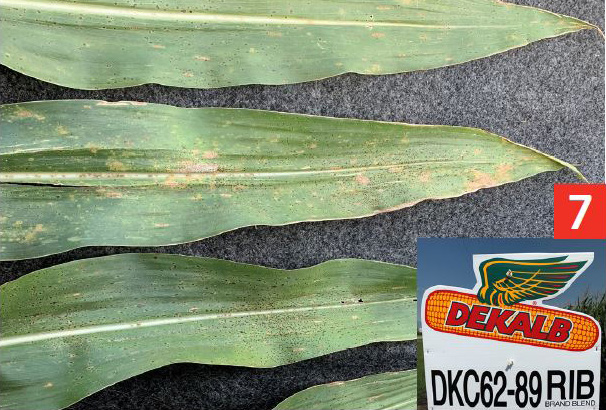
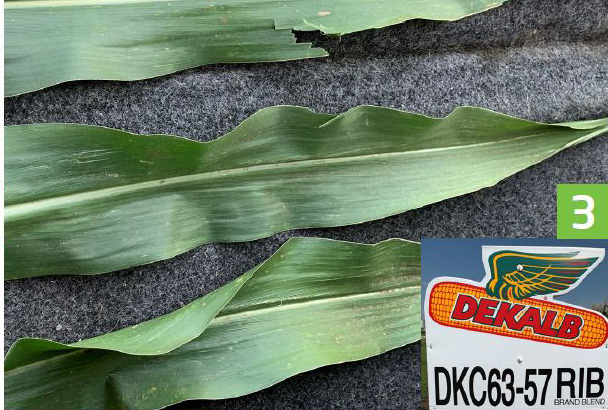

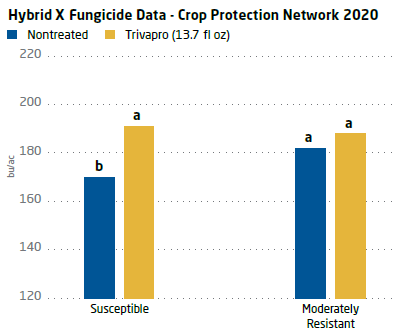
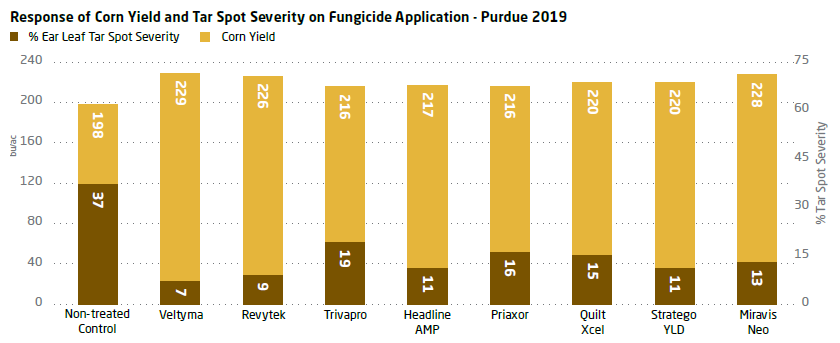
Data obtained from HERE>
Multi-Fungicide Pass.
- V6 followed by (fb) VT/R1 did not reduce tar spot severity compared to VT/R1 alone.
- VT fb 2nd pass fungicide should be focused during R3-R4 if the environment favors disease development for best ROI and protection of yield.
- V10-V14 fb R1-R2 is another option for a multifungicide pass to reduce tar spot severity and increase yield. This application timing pairs nice with BRANDT Smart K B or BRANDT Smart B-Mo to provide foliar nutrition when corn needs it most.
- Greater responses are seen from 2 pass fungicide when a VT/R1 or sooner application is initially made.
- R1 fb R4 application of Trivapro in Oakford, IL in 2021 showed a 13 bu/ac advantage in a field infested with tar spot.
- Multi-fungicide pass should be made based on weather forecast and hybrid response for best chances of ROI.
In-Furrow Fungicides
- Foliar fungicides are more effective for managing tar spot than in-furrow. Xyway not labeled for tar spot control and these results indicate why.
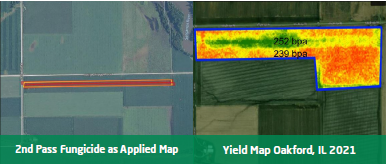
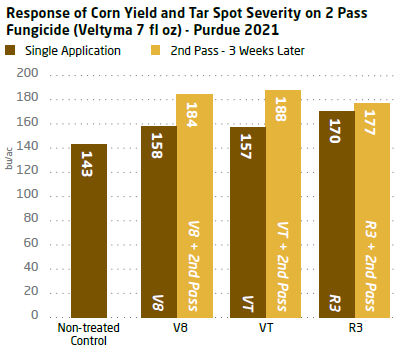
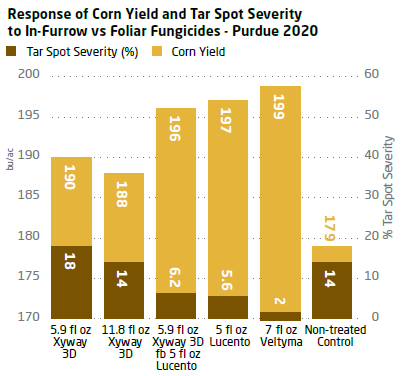
Secondary Management Practices
If tar spot has already occurred in an area, secondary management tactics alone will likely not be enough. These practices should be used along with primary management to reduce inoculum load.
- Avoid late planting, if possible: earlier planted neighboring corn fields can act as a source of inoculum early in the season.
- Management of corn residue: Tar spot can overwinter on residue. Promote breakdown of corn residue as fast as possible.
- Crop rotation: Rotation crops will reduce inoculum level over time. However, first year corn fields can still become infected.
- Weed control: Tar spot can infect volunteer corn if left unchecked or managed too late, creating a fresh batch of inoculum for the following year.
- Fertility Management: Managing K levels and having high base saturation K (at least 4%) will limit stress and increase stalk integrity.
Summary
Tar spot can have drastic impacts on yield if left unchecked. In previous “epidemic” years the Crop Protection Network (CPN) estimated a 30 bu/ac yield loss from corn infected with tar spot across the Midwest Region. It’s likely that 2021 resulted in similar loses, possibly even greater for this region due to excess rainfall. Planting tolerant/healthy hybrids, aggressive scouting, timely fungicide applications, and reducing leaf wetness seem to be the best tools we currently have to manage tar spot.
Please visit with your BRANDT Professional for more information.
References
- Groves, C. L., Kleczewski, N. M., Telenko, D. E., Chilvers, M. I., & Smith, D. (2020). Phyllachora maydis ascospore release and germination from overwintered corn residue. Plant Health Progress, 21(1), 26-30.
- Kleczewski, N. M., Chilvers, M., Mueller, D. S., Plewa, D., Robertson, A. E., Smith, D. L., and Telenko, D. E. (2019). Corn disease management: Tar spot. Crop protection network CPN 2012-W.
- Kleczewski, N. M., Donnelly, J., & Higgins, R. (2019). Phyllachora maydis, causal agent of tar spot on corn, can overwinter in Northern Illinois.
- Mahuku, George & Shrestha, Rosemary & San Vicente, Felix. (2013). Tar spot complex of maize: Facts and actions.
- Ruhl, G., Romberg, M. K., Bissonnette, S., Plewa, D., Creswell, T., & Wise, K. A. (2016). First report of tar spot on corn caused by Phyllachora maydis in the United States. Plant Disease, 100(7), 1496.
- Shim, S and Telenko, D. (2022). Applied Research in Field CropPathology for Indiana – 2021. Purdue Field Crop Pathology. BP-217-W.
- Telenko, D., and Creswell T. (2019). Diseases of corn: Tar spot. Purdue Botany & Plant Pathology (BP-90-W).
- Telenko, D., Chilvers, M., Robertson, A., Tenuta, A., & Smith, D. (2021). Will a second fungicide be worth the cost for tar spot management? Crop Protection Network. CPN 2018.
- Telenko, D. et al. (2019). How tar spot of corn impacted hybrid yields during the 2018 midwest epidemic. Crop Protection Netweok. CPN 2014.
- Telenko, D. (2020). Applied research in field crop pathology for Indiana- 2019. Purdue Field Crop Pathology. BP-205-W.
- Telenko, D. (2021). Applied research in field crop pathology for Indiana-2020. Purdue Field Crop Pathology. BP-216-W.
- Telenko, D. (2022). Management Considerations for Tar Spot in Indiana. Purdue Field Crop Pathology.
- Valle-Torres, J., et al. (2020). Tar spot: An understudied disease threatening
